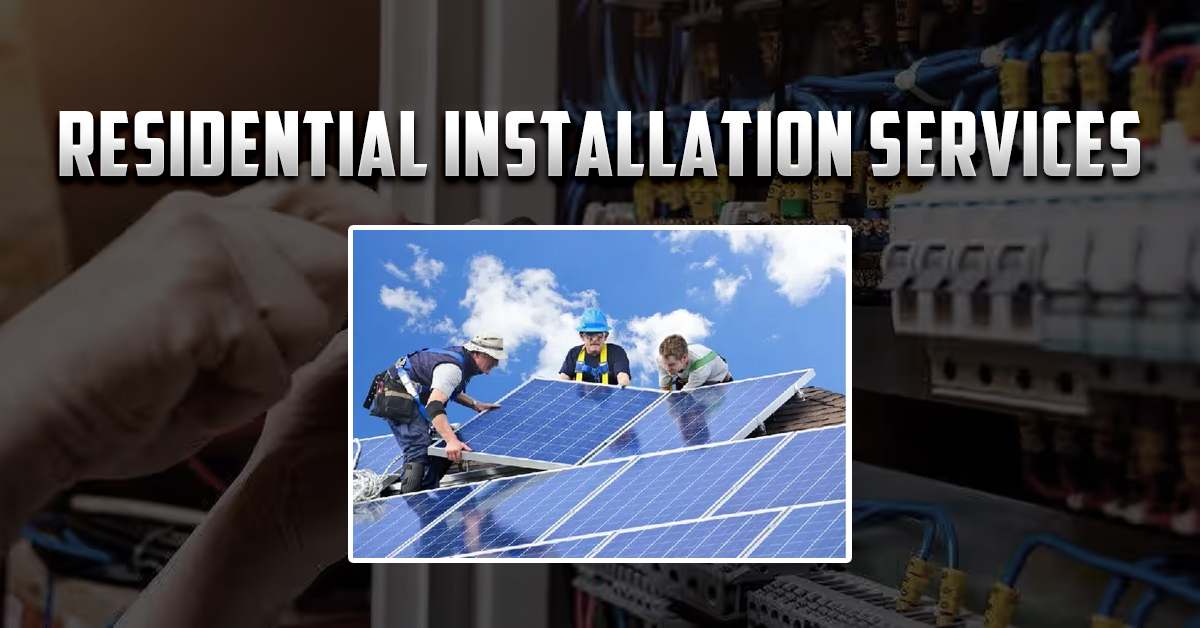Planning Your Residential Installation
When planning a residential installation, it’s important to focus on a few key areas. Understanding the steps involved, picking the right materials, and considering energy efficiency are all crucial.
Understanding the Installation Process
Knowing the installation process is helpful in managing your expectations and planning appropriately. Start by working with a reliable contractor who will conduct an inspection to assess your needs. This inspection helps outline the scope of the project and provides a detailed quote. You will likely go through stages like removing old materials, preparing the site, and installing new components. Clear communication with your contractor is key to addressing any concerns or adjustments along the way.

Choosing the Right Roofing Materials
Selecting roofing materials depends on various factors such as climate, budget, and aesthetic preferences. Common options include asphalt shingles, metal, and tile. Each material has its own benefits; for instance, asphalt is affordable and easy to install, while metal roofing offers longevity and energy savings. Consulting with a professional can guide you in picking materials that fit your personal needs and local weather conditions. Consider long-term value along with upfront costs when making your decision.
Evaluating Potential Energy Efficiency Improvements
Enhancing energy efficiency in your home during installation can lead to significant savings. Consider options like installing insulation, upgrading windows, or selecting reflective roofing materials. Energy-efficient upgrades not only cut down on utility bills but also contribute to environmental sustainability. Check for potential rebates or incentives offered by local governments or energy providers to offset costs. Begin by assessing which elements of your home could benefit most from efficiency improvements, ensuring you make informed choices.
The Roof Installation Journey
Installing a roof is a major step in home improvement, involving careful planning and various stages to ensure durability and comfort for your house. The process is unique for new installations and replacements, with costs that need careful planning.
Initial Steps for New Roof Installation
Planning Your New Roof Installation
The first step in installing a new roof is proper planning. Start by selecting the appropriate roofing material. Options like asphalt shingles, metal, and tiles offer varying levels of durability, aesthetics, and cost. Choose based on your budget, local weather conditions, and the roof’s expected lifespan.
Before installation begins, ensure that all permits and logistics are in place. Site preparation, including safety arrangements, is crucial for a smooth process. Working with experienced contractors ensures compliance with building codes and avoids unnecessary delays.
Key Considerations for Roof Replacement
Removing Old Materials
A roof replacement begins with removing the old roofing materials. This process is essential for inspecting the underlying structure. Addressing any signs of damage, such as rotting wood or weakened supports, is critical to ensure the new roof has a stable foundation.
Preparing Your Home Environment
Expect noise and debris during the roof replacement process. Preparing your home environment by moving fragile items and protecting furniture helps minimize disruption. Discuss cleanup procedures with your contractor to ensure the site is left clean and safe after the work is completed.
Choosing the Right Materials
Selecting replacement materials involves considering weather conditions and your home’s structural requirements. For instance, metal roofs are durable and withstand extreme climates, while asphalt shingles offer affordability and ease of installation. Consult your contractor for recommendations tailored to your home’s needs.
Installing Underlayment and Flashing
Both underlayment and flashing play critical roles in protecting your home from water damage. The underlayment sits directly under the roofing material, acting as a secondary barrier against leaks. You can choose from felt, synthetic, or newer self-adhering options, each with its benefits.
Flashing is installed around edges, valleys, and any roof interruptions like chimneys. It ensures water is directed away, maintaining the roof’s integrity. Proper installation is crucial here, as any gaps or incorrect placements can lead to leaks.
Roof Installation Costs and Budgeting
Roof installation costs can vary widely. Factors influencing costs include material choice, roof size, and complexity of the roof design. For example, a steep or complex roof will usually incur higher labor costs.
It’s important to budget for unforeseen expenses too, such as repairing any underlying structural damage discovered during installation. Requesting detailed estimates from multiple contractors helps in planning and can reveal potential savings, ensuring you get the best value for your investment.
Window Installation Essentials
When planning for window installation in your home, it is crucial to understand the types of windows and installation techniques. Additionally, knowing how to care for your windows after installation helps maintain their longevity and efficiency.
Types of Windows and Their Features
Double-Hung Windows
Double-hung windows are a popular choice due to their versatility and ease of cleaning. They feature two operable sashes that slide vertically, allowing excellent ventilation. These windows are suitable for a variety of home styles, blending functionality with aesthetics.
Casement Windows
Casement windows are hinged at the side and open outward, making them ideal for superior ventilation. These windows seal tightly when closed, enhancing energy efficiency. Their modern design works well for contemporary homes.
Picture Windows
Picture windows are large, fixed panes designed to frame outdoor views. They don’t open, making them highly energy-efficient. Perfect for rooms with scenic views, they allow abundant natural light into the home.
Window Installation Techniques
Precision Measurements
Accurate measurements are essential for ensuring a snug fit. Professionals take detailed dimensions of the rough opening to avoid gaps or misalignment, which could compromise energy efficiency and functionality.
Proper Alignment
Correct alignment ensures smooth operation, especially for operable windows like double-hung or casement models. The frame must be leveled and squared during installation to maintain ease of use and long-term performance.
Sealing and Weatherproofing
After installation, weatherproofing is critical to prevent air and water leaks. Professionals use high-quality caulk and insulation to seal gaps. Proper sealing enhances energy efficiency and protects against drafts and moisture.
Post-Installation Care and Maintenance
After installation, regular maintenance is critical to keeping your windows in good shape. Start by checking the seals frequently to ensure they’re intact. Broken seals can lead to air leaks and higher energy costs.
Cleaning the glass and frames regularly prevents grime buildup and keeps your windows looking their best. Use a mild cleaner or a vinegar-water solution for spotless glass. Pay attention to window tracks and hinges, as debris can accumulate and affect their operation.
Inspect your windows seasonally for any damage like cracks or broken locks. Prompt repairs can prevent these issues from worsening. Remember, well-maintained windows contribute not only to your home’s aesthetic appeal but also to its energy efficiency and overall comfort.
Selecting Roofing Contractors
Choosing the right roofing contractor is crucial for ensuring high-quality work and a hassle-free project. Key factors to consider include verifying qualifications and experience, and understanding what to expect during the final inspection.
Qualifications and Experience
Check Licenses and Certifications
Hiring a contractor with a valid license ensures they comply with local safety and performance standards. Check with your state’s licensing board to verify the contractor’s credentials. Certifications in specific skills, like plumbing or electrical work, can indicate a higher level of expertise.
Ensure Adequate Insurance Coverage
Contractors should have general liability insurance to cover any accidental damages that may occur during your project. Additionally, verify that they carry workers’ compensation insurance to protect you from liability in case a worker is injured on your property.
Look for Experience and References
An experienced contractor is better equipped to handle unexpected challenges efficiently. Ask for a portfolio of past work or testimonials from previous clients. Check online reviews and ratings to gauge their reputation and reliability. Experience ensures the contractor can deliver high-quality results on time and within budget.
Preparing for the Final Inspection
As the project nears completion, the final inspection ensures everything is done correctly. This step includes checking all repairs, installations, and any replaced or restored sections of the roof. Flashing, gutters, and eaves should be thoroughly examined for any overlooked issues.
Before this inspection, discuss with your contractor what to expect. Ask questions about the inspection process and who will be involved. Both you and the contractor should ensure any required permits have been obtained and followed. Preparing for this step helps avoid any surprises and ensures peace of mind after the contractor leaves.
Material Considerations and Longevity
Choosing the right roofing material is crucial for the long-term health of your home and can impact your energy bills. Options like asphalt shingles, metal, and tiles each offer different benefits and lifespans. Assessing these can guide you to a suitable choice for your home.
Asphalt Shingles vs. Metal Roofing
| Feature | Asphalt Shingles | Metal Roofing |
|---|---|---|
| Cost | Affordable, lower initial cost | Higher initial cost |
| Durability | Lasts 20–30 years | Lasts 40–70 years |
| Maintenance | Requires more frequent replacements | Minimal maintenance required |
| Weather Resistance | Good resistance but less durable in harsh weather | Excellent resistance to fire and severe weather |
| Energy Efficiency | Standard energy efficiency | Reflective, reduces cooling costs |
| Style Options | Wide variety of colors and styles | Fewer options but sleek and modern |
Durability and Lifespan of Roofing Tiles
Roofing tiles, such as clay, concrete, and slate, boast impressive longevity. These materials can last over 50 years, with some options like slate lasting more than a century. Clay tiles not only provide excellent weather resistance but also add a unique aesthetic to your home.
Concrete tiles are also a sturdy choice, known for their weatherproof properties and energy efficiency. While more expensive than shingles, tiles’ durability often justifies the cost. Their ability to withstand severe weather conditions makes them an excellent option, especially in locales prone to extreme climates.
Frequently Asked Questions
What should I prepare for when scheduling a residential HVAC installation?
Clear the area where technicians will work. Make sure they can easily access your HVAC system. Removing furniture and other items from the work area helps. Arrange for someone to be home during the installation.
What are the key steps involved in installing a new HVAC system at home?
Installation involves removing old equipment, setting up ductwork, and installing new units. Wiring, connections, and system testing are part of the process. Each step ensures the system operates safely and efficiently.
Can I install an HVAC system by myself, and what are the challenges?
Installing HVAC systems requires technical expertise. It’s a complex task with electrical and mechanical components. Doing it yourself might lead to safety hazards and void warranties. Professional installation is recommended for safety and efficiency.
What does the process of installing a new central AC unit entail?
The process includes removing the old unit, positioning the new one, and connecting proper wiring. Installers charge the system with refrigerant and check for leaks. They also ensure controls and components work correctly before finishing.
After my AC unit installation is complete, what are the next steps?
After installation, you should schedule a follow-up check to ensure everything functions well. Learning to use the thermostat and understanding the maintenance schedule are important for system longevity. Regular maintenance will help keep your system running at its best.
What considerations should be made when choosing a furnace and AC unit for home installation?
Consider the size of your home, climate, and energy efficiency ratings. A system too large or too small affects performance and costs. Look for units with high efficiency to save on energy bills. Consult with professionals to help choose the right system for your needs.



